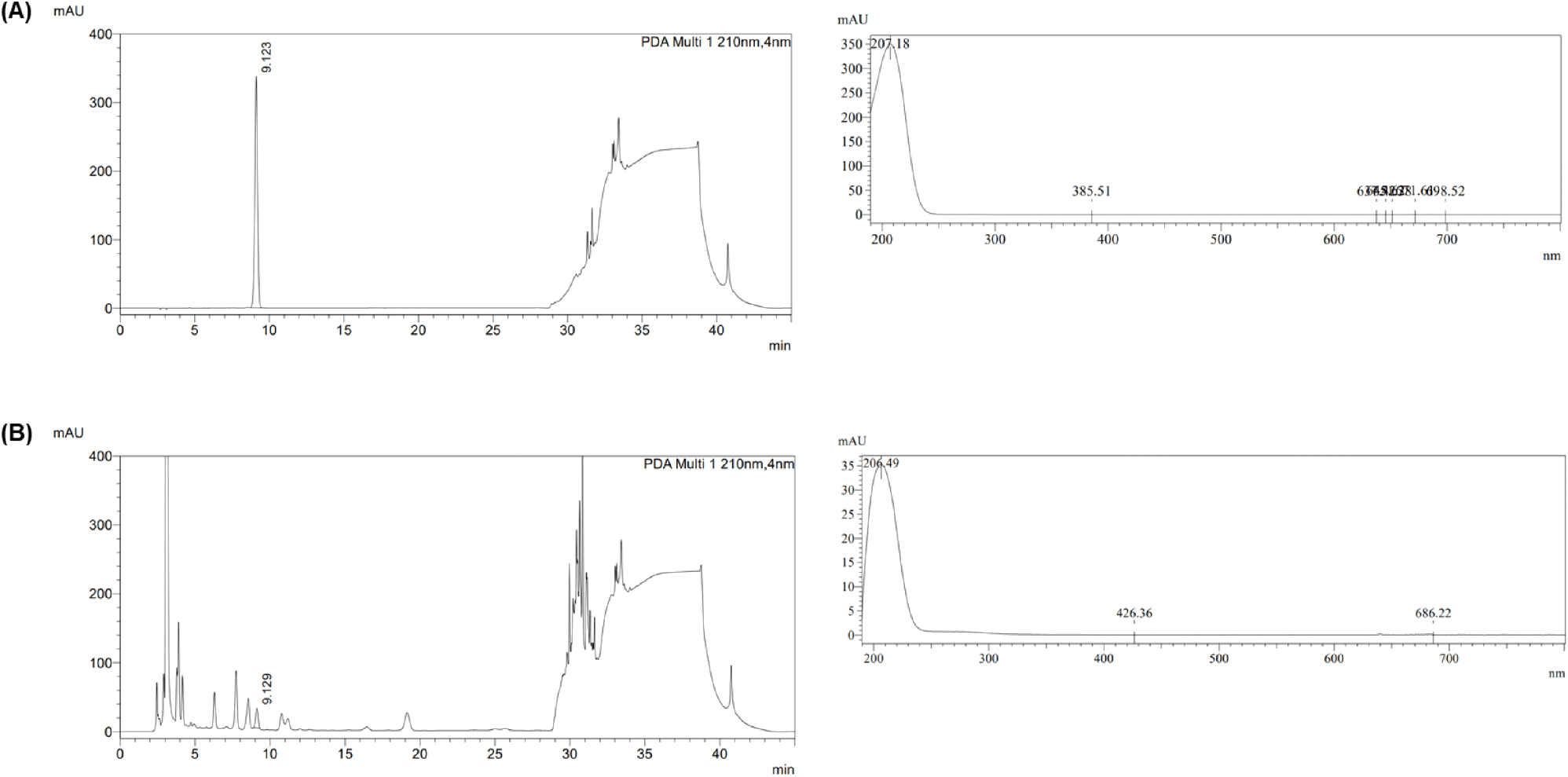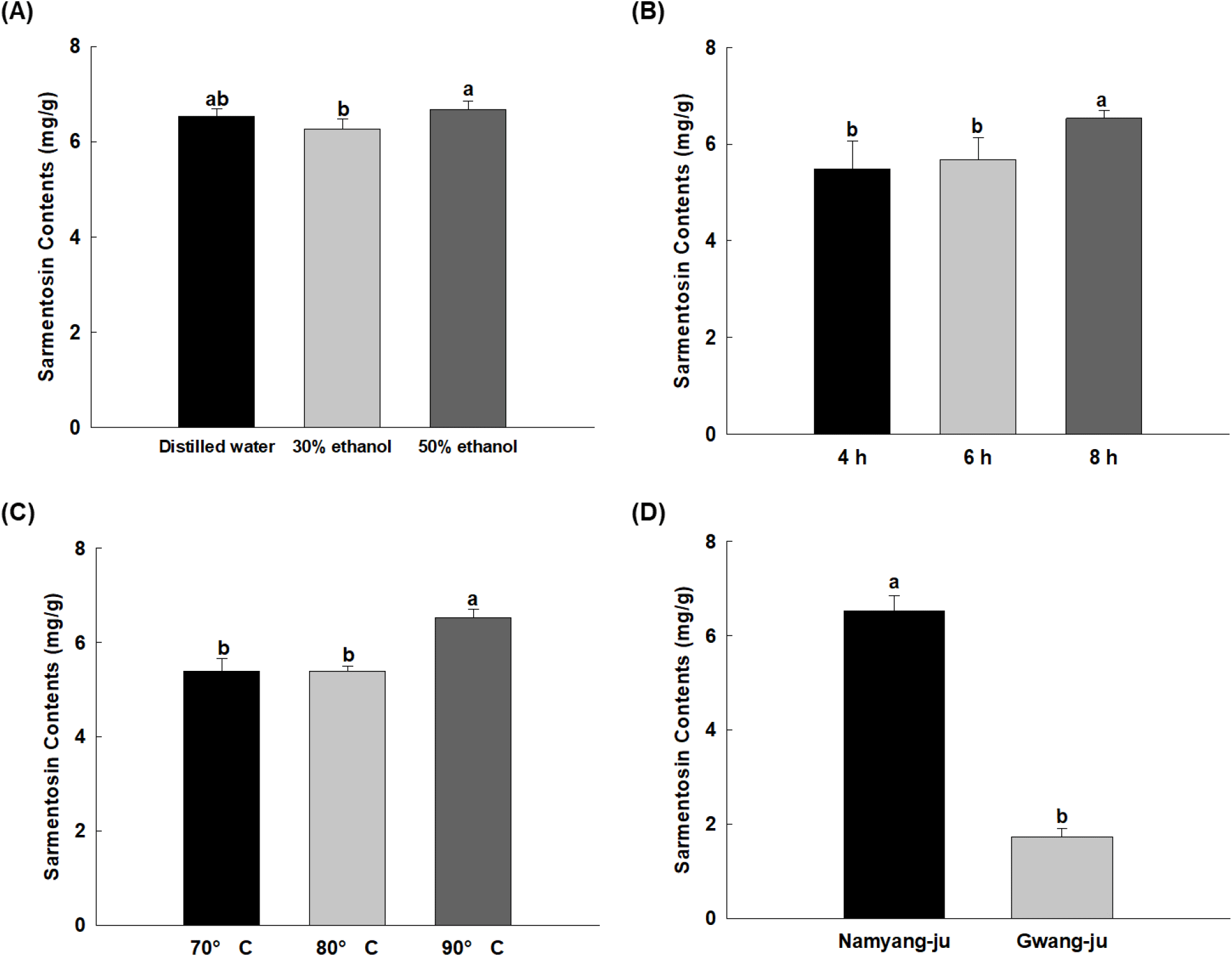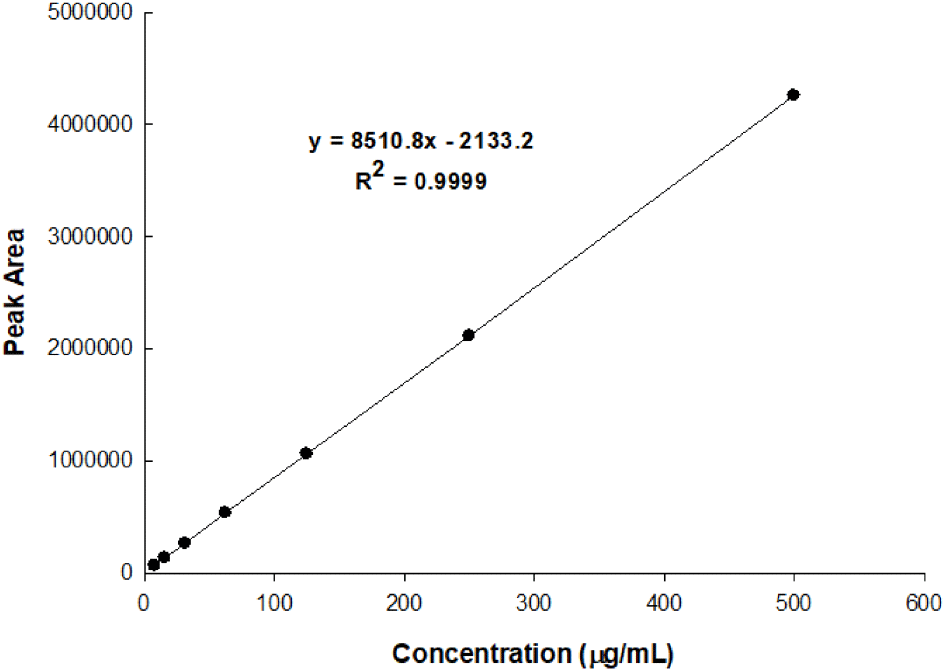1. 서론
수분초(Sedum sarmentosum)는 돌나물과에 속하는 다년생 식물로 흔히 돌나물이라고도 불린다. 습기가 있는 땅이나 암석 위에서 자라며 한국 전역, 일본, 중국 등지의 산에 분포한다고 알려져 있다(Kim과 Lee, 2007). 수분초에는 항염증 및 항산화 활성을 가지는 비타민 C를 비롯하여 칼슘 및 철분이 풍부하며 sedoheptulose, sucrose, fructose 등의 당질이 함유되어 있다(Medoro 등, 2023; Sim 등, 2008). 또한, triterpenes(He 등, 1998), alkaloids(Kang 등, 2000), flavonoids 및 다당류(Zhang 등, 2021; Zong 등, 2023) 등의 다양한 활성 물질들이 보고되어있다. 중국 약전에는 수분초에 대하여 전통 중의약으로서 황달 완화 및 바이러스성 간염 치료의 효능이 기록되어있으며(Liu 등, 2022) 한방에서는 석상채(石上採)나 불갑초(佛甲草)라고도 불리며 인후염이나 만성 간염 등의 치료에 이용되 고 독충이나 해충에 물렸을 때 환부에 붙이기도 한다(Ahn과 Lee, 2004; Lee 등, 2007). 특히 최근에는 알코올로 인한 간 손상에 대한 예방 및 보호 효과(Huang 등, 2018; Lian 등, 2010), 간 섬유화 완화 및 염증 억제와 신장 손상의 완화 등(Lu 등, 2019)의 효과 등의 간 질환 치료 효과에 대해 활발히 연구되고 있다. 수분초에 함유되어 있는 생리활성 물질 중 하나인 sarmentosin은 Nrf2 경로 활성화를 통한 산화 스트레스 억제 효과를 기반으로 급성 간 손상 완화(Jiang 등, 2022), 간세포암 성장 억제(Jiang 등, 2023), 심장 독성의 예방 및 치료(Lomiwes 등, 2024)에 대한 효능이 입증되고 있다. 또한 지질 축적 억제를 통한 지방간 예방 효능(Guo 등, 2024)과 신경전달물질 분해 효소인 monoamine oxidase-B 억제를 통한 정신건강과 관련된 생리활성 효능이 있다(Lin 등, 2024). Sarmentosin은 불포화 γ-hydroxynitrile glucoside 구조의 물질로 식물에서 L-isoleucin으로부터 합성되는 것으로 알려져 있으며(Bjarnholt 등, 2012), 가구(Piper sarmentosum)의 뿌리(Pittaya 등, 2006)나 돌나물과의 Rhodiola 속 식물인 R. sacra, R. crenulata, R. sachalinensis에서 확인되어 왔다(Mook 등, 2002; Yang 등, 2012).
건강 기능성 소재로서 수분초를 활용하여 제품개발을 하기 위해서는 원료의 표준화를 통해 과학적 근거를 토대로 기능성과 안전성을 입증하여야 한다. 건강기능식품에서의 표준화(standardization)란 천연물질에 함유되어 있는 고유한 성분의 변동을 최소화하여, 생산되는 배치(batch)에 상관없이 일정한 품질을 유지하기 위해 원재료의 생산에서부터 제조 과정 전반에 걸쳐 사용된 기술과 정보를 관리하는 것을 말한다. 이를 관리하기 위한 가장 일반적인 지표가 지표성분(marker compound)이다(KFDA, 2008; Ryu 등, 2024). 지표성분은 원료 중에 함유된 화학적으로 규명된 성분 중에서 품질관리의 목적으로 정한 성분으로, 지표성분 분석을 위해서는 최적의 분석법을 설정하는 과정이 필요하다(Jeon 등, 2016). 또한, 천연물에 존재하는 지표성분의 함량 기준 및 규격을 설정하기 위해서는 공인된 방법을 사용하여 분석 방법의 타당성 및 신뢰성이 검증되어야 한다(Choi 등, 2020; Jeon 등 2023). Lu 등(2021)은 LC-MS 분석을 통해, Xu 등(2000)은 NMR 분석을 통해 수분초에서 sarmentosion의 존재를 확인하였으며, Fernandes 등(2021)은 1H NMR을 이용하여 Bryophyllum pinnatum에서 sarmentosin을 정량 분석한 바 있다. 수분초의 기능성에 관한 연구는 지속적으로 이루어지고 있음에 비해 수분초 내 sarmentosin의 구체적인 함량 분석 및 분석법 개발에 관한 연구는 부족하며 특히 HPLC-PDA 분석에 대한 연구는 재현성이 낮다는 문제점이 있다.
따라서 본 연구에서는 수분초의 주요 물질인 sarmentosin을 지표성분으로 설정하였으며 실제 산업 현장에서 활용이 가능한 HPLC-PDA를 이용한 분석법을 확립함으로써 수분초의 산업적 활용 증대에 기여하고자 하였다. 또한 해당 분석법에 대한 유효성 검증을 진행하였으며 이를 활용하여 수분초의 최적의 추출조건을 확립하고자 하였다.
2. 재료 및 방법
실험에 사용된 수분초(Sedum sarmentosum)는 2024년도 3월에서 5월 사이에 재배된 광주산 및 남양주산 수분초 건조물을 ㈜팜스빌에서 제공받았으며 sarmentosin 표준물질은 Chem Faces(Wuhan, China, ≥98%)에서 구입하였다. 분석에 사용한 phosphoric acid 등의 시약들은 DAEJUNG(Seoul, Korea)에서 구입하였으며 methanol은 J.T. Baker(Phillipsburg, NJ, USA)에서 구입하여 사용하였다. 시료 전처리 및 이동상에 사용되는 물은 3차 증류수(triple distilled water, DDW)로 18.2 MΩ 이상인 것을 사용하였다.
수분초 건조물로부터 sarmentosin을 추출하기 위해 분쇄기(YB-800B, Sufeng Industrial and Trading Co., Ltd., Yongkang, China)를 사용하여 원물을 분쇄한 후 25 mesh sieve로 여과하였다. 균질화한 원물 25 g을 칭량하여 용매 500 mL를 넣고 환류냉각기를 부착한 추출장치에서 다양한 추출 조건(추출 용매, 추출 시간, 추출 온도)으로 3회 반복하여 추출하였으며. 추출조건에 따른 결과는 3회 반복의 평균으로 나타내었다. 추출 용매는 증류수(distilled water, DW), 30%(v/v) ethanol, 50%(v/v) ethanol을 사용하였으며, 추출 시간은 4시간, 6시간, 8시간으로 하였고 추출 온도는 70°C, 80°C, 90°C로 설정하여 추출하였다. 추출액을 5C filter paper(ADVANTEC, Tokyo, Japan)로 여과한 후, 회전진공농축기(N3000, EYELA Co., Ltd., Tokyo, Japan)를 사용하여 감압농축한 다음 -40°C 이하에서 일주일간 동결건조(FD8508, Ilshinbiobase Co., Ltd., Dongducheon, Korea)하여 시료로 하였다. 동결 건조된 시료 100 mg에 대하여 10 mL 부피플라스크를 이용해 10,000 μg/mL의 농도가 되도록 3차 증류수로 정용한 후, 0.45 μm membrane filter(Cytiva, Marlborough, MA, USA)로 여과하여 시험용액으로 사용하였다.
Sarmentosin 표준품은 증류수에 용해하여 1,000 μg/mL가 되도록 stock solution을 조제하였으며 이를 영하 20°C의 냉동고에 보관하였다. 분석조건 확립 및 유효성 검증 시험을 위한 표준용액은 stock solution에 증류수를 가해 500, 250, 125, 62.5, 31.3, 15.6, 7.81 μg/mL 농도로 희석하여 사용하였다.
Photodiode array detector(PDA)가 장착된 HPLC(LC-40XR Series, SHIMADZU, Kyoto, Japan)를 사용하여 분석하였다. 분석용 column은 Shiseido CAPCELL PAK C18(4.6 mm × 250 mm, 5.0 μm)을 사용하였으며 column 온도는 40°C로 설정하였다. 이동상은 0.5% phosphoric acid 함유 수용액과 methanol을 각각 이동상 A와 B로 하여, A:B 혼합비를 100:0(5분), 99:1(25분), 0:100(30-35분), 100:0(40-45분)의 조건으로 분석하였다. 주입량은 10 μL이었고 유속은 1.0 mL/min이었으며, 검출기 파장은 210 nm에서 측정하였다.
분석법의 유효성 검증은 International Conference for Harmonization(ICH) 가이드라인(ICH, 2021) 및 AOAC 가이드라인(AOAC, 2023)을 근거로 하여 특이성(specifiity), 직선성(linearity), 정밀성(precision), 정확성(accuracy), 검출한계(limits of detection, LOD) 및 정량한계(limits of quantification, LOQ)를 이용하여 분석법의 유효성을 검증하였다.
Sarmentosin 표준품과 수분초 추출물을 HPLC-PDA로 분석하여 피크의 머무름 시간(retention time, RT)과 분리도(resolution, Rs)를 확인함으로써 시료 내에서 sarmentosin이 선택적으로 분리되는지 평가하였다. 또한, PDA 스펙트럼 비교를 통해 분석법의 특이성을 확인하였다.
직선성은 sarmentosin 표준품을 희석하여 7.81-500 μg/mL 농도로 제조해 HPLC로 3반복 분석하여 피크에 대한 면적과 농도비의 관계를 표시하는 검량선을 작성하고 검량선으로부터 얻어진 상관계수(correlation coefficients, R2) 값을 통해 확인하였다.
정밀성 및 정확성을 확인하기 위해 함량을 알고 있는 수분초 추출물에 sarmentosin 표준용액을 15.6, 62.5, 250 μg/mL의 농도로 첨가하여 분석하였다. 하루에 3회 HPLC로 반복 분석하여 일내(intra-day) 정밀성 및 정확성을 확인하였고 3일간 HPLC 반복 분석을 통해 일간(inter-day) 정밀성 및 정확성을 확인하였다. 정밀성은 반복하여 얻은 결괏값의 상대표준편차(relative standard deviation, RSD)로 확인하였으며 정확성은 회수율로 평가하였다. 회수율은 첨가한 농도에 대비한 회수농도를 다음 식에 따라 계산하였다.
Cf: Concentration of spiked sample
Cu: Concentration of sample
Ca: Concentration of standard
수분초 추출물에서 sarmentosin의 존재를 검증하기 위해 LC-MS/MS분석을 진행하였다. 분석기기는 4500 QTRAP LC-MS/MS system(AB Sciex Corp., Framingham, MA, USA)을 사용하였으며 column은 Shiseido CAPCELL PAK C18(4.6 mm × 250 mm, 5.0 μm)을 column 온도 35°C로 설정하여 분석에 사용하였다. 이동상은 0.05% trifluoroacetic acid 함유 수용액과 acetonitrile을 이동상 A와 B로 하여, A:B 혼합비를 95:5(30분), 5:95(30-44분), 95:5(47-60분)으로 분석하였다. 주입량은 30 μL이었으며, 유속은 1.0 mL/min이었다. 질량분석기의 세부조건으로는 전자분무 이온화(electrospray ionization) positive 모드로 curtain gas 172 kPa, collision gas는 medium, nebulizing gas 345 kPa, turbo gas 345 kPa, source 온도 500°C, ionspray voltage 5.5 kV으로 설정하여 분석하였다.
3. 결과 및 고찰
특이성은 불순물 등이 혼합되어있는 상태의 시료에서 분석대상 물질을 선택적으로 측정할 수 있는 능력을 말한다. Sarmentosin 표준용액에서는 9.123분에서, 시험용액에서는 9.129분에서 피크가 검출되었으며 해당 피크에 대한 PDA spectrum 결과에서도 190-800 nm 범위에서 동일한 패턴의 spectrum을 나타내었다(Fig. 1). 분리도값은 1.71-1.83의 범위로 나타나 분리도≥1.5을 충족하였다. 이를 통해 sarmentosin이 다른 물질의 간섭 없이 단일 피크로 검출됨을 확인하였으며 본 시험법이 sarmentosin 분석에 대한 특이성을 가진다는 것을 입증하였다.

직선성은 시험방법이 일정한 범위 내에 있는 검체 중 분석대상물질의 농도에 대하여 직선적인 측정값을 얻어낼 수 있는 능력을 뜻한다. 표준용액을 7.81, 15.6, 31.3, 62.5, 125, 250, 500 μg/mL로 희석하여 3회 반복 분석을 통한 HPLC 피크의 면적과 각 농도 간의 검량선을 작성하여 얻어진 상관계수(R2) 값을 통해 직선성을 확인하였다. Sarmentosin의 표준검량선은 y= 8510.8x-2133.2으로 나타났으며 상관계수 값은 0.999 이상의 높은 직선성을 나타내어 분석에 적합한 것으로 확인되었다(Fig. 2).
정밀성은 균일한 검체로부터 여러 번 채취한 시료를 정해진 조건으로 분석하였을 때 각각의 측정값들 사이의 근접성을 의미하며, 정확성은 시험방법에 따른 측정값이 이미 알고 있는 참값이나 표준값에 근접한 정도를 나타낸다. 농도를 알고 있는 수분초 추출물에 sarmentosin 표준용액을 각각 저농도(15.6 μg/mL), 중간농도(62.5 μg/mL), 고농도(250 μg/mL)가 되게 첨가한 뒤 HPLC-PDA로 분석하여 정밀성과 정확성을 확인하였다. 각 측정 결괏값 사이의 근접성을 확인하여 상대표준편차(RSD) 값으로 정밀성을 평가하였고 회수율을 측정하여 정확성을 평가하였다. 일내 정밀성은 1.18-1.42%, 일간 정밀성은 0.51-1.11%를 나타내어 시료 내 sarmentosin의 농도를 고려하였을 때 AOAC 기준인 2% 이하임을 확인하였다(AOAC, 2023). 회수율에 따른 일내 정확성은 99.34-101.29%를 나타내었으며 일간 정확성은 99.54-103.23%를 나타내어 AOAC(2023)의 기준인 0.1%(1 mg/g) 일 때 90-108%의 범위에 충족되었다(Table 1).
검출한계는 균질화된 검체 중 존재하는 분석 대상 물질에서 최소한의 검출 가능한 양을 뜻하며, 정량한계는 검체 중 정량값으로 표현할 수 있는 분석 대상물질의 최소량을 나타낸다. Sarmentosin의 검출한계는 0.27 μg/mL, 정량한계는 0.81 μg/mL로 나타났다(Table 2). 이는 Fernandes(2021) 등이 제시한 1H NMR 분석법의 LOD, LOQ 값보다 낮은 값으로 HPLC-PDA를 이용하여 sarmentosin의 미량 분석이 가능한 것을 확인하였다. 이상의 결과를 통해 수분초 추출물에서 HPLC를 이용해 sarmentosin 정량분석이 가능한 것으로 나타났다.
| Analyte | Range (μg/mL) | Slope | Intercept | Correlation coefficient (R2) | LOD (μg/mL) |
LOQ (μg/mL) |
|---|---|---|---|---|---|---|
| Sarmentosin | 7.81-500 | 8,510.79 | −2,133.18 | 0.9999 | 0.27 | 0.81 |
확립 및 검증된 분석법을 이용하여 추출 용매와 시간, 온도, 원산지별 sarmentosin의 함량을 분석한 결과는 Fig. 3과 같다. 추출 용매에 따른 비교를 위해 90°C에서 8시간 동안 추출했을 때 sarmentosin 함량은 증류수 추출물에서 6.53±0.17 mg/g, 30% ethanol에서 6.27±0.21 mg/g, 50% ethanol에서 6.68±0.18 mg/g으로 나타났다. 30% ethanol 추출물과 50% ethanol 추출물 간에는 유의적인 차이가 있었으나, 증류수를 기준으로 30% ethanol, 50% ethanol 추출물을 비교하였을 때는 유의적인 차이가 확인되지 않았다. 또한, 추출 용매에서의 ethanol 농도가 높을수록 제조 공정 과정에서 회수율이 낮아질 뿐만 아니라 발화의 위험성도 상승한다고 보고되었다(Lee 등 2023; Park 등, 2004). 따라서 경제적 효율성 측면을 고려할 때 수분초 추출 용매는 증류수가 적합한 것으로 판단되었다. 추출 시간에 따른 비교를 위해 증류수를 용매로 하여 90°C에서 추출하였을 때 4시간 추출(5.49±0.57 mg/g)과 6시간 추출(5.68±0.46 mg/g)에서 sarmentosin 함량은 유의한 차이가 나타나지 않았지만 8시간(6.53±0.17 mg/g)에서는 유의한 차이를 나타내었다. 따라서 8시간의 추출이 적절할 것이라 판단된다. 증류수로 8시간 동안 추출하여 추출 온도별 sarmentosin 함량을 비교하였을 때, 70°C 추출물에서 5.39±0.27 mg/g, 80°C 추출물에서 5.39±0.11 mg/g, 90°C 추출물에서 6.53±0.17 mg/g으로 70°C와 80°C 추출물에 비해 90°C 추출물에서 유의적으로 높은 함량을 나타내었다. 이는 열처리로 인한 세포벽의 투과성의 증대로 내부 물질의 용출이 증가되었기 때문으로 사료된다(Kim 등, 2022). 위의 결과를 바탕으로 수분초에서 sarmentosin 최적 추출 조건은 8시간 동안 90°C의 증류수로 추출하는 것으로 확립하였다. 최적 추출 조건으로 추출한 수분초 원산지별 sarmentosin 함량 비교에서는 남양주산에서 6.53±0.31 mg/g, 광주산에서 1.73±0.17 mg/g의 함량을 보여 남양주산 수분초에서 sarmentosin의 함량이 유의적으로 더 높은 것을 확인하였다. 식물은 이동성이 없기 때문에 주변 환경으로부터 스트레스를 받으면 스트레스 저항성 단백질과 조절 단백질을 생성함으로써 방어기작을 통해 스트레스에 대응한다(Lee, 2020). Sarmentosin은 γ-hydroxynitrile glucoside로 식물 내에서 hydroglucosides는 식물의 방어와 관련된 cyanogenic glucosides의 합성 경로 중에 생성되는 물질로 보고되어 왔다(Bjarnholt, 2008). 남양주와 광주 산에서 sarmentosin의 함량에 차이가 나타나는 것은 다른 재배지에 따라 토양, 수분, 해충 등 다른 환경적 요인에 노출되어 sarmentosin 합성 경로에 대한 자극 정도가 달랐기 때문으로 추측된다. 또한 같은 돌나무과 Sedum속인 Sedum rubens L.에서는 생장 시기에 따라 essential oil의 조성이 다르게 나타났다(Odeh, 2023). 이를 통해 본 연구에서 사용된 남양주산 수분초와 광주산 수분초의 재배 시기 또한 sarmentosin의 함량에 대해 영향이 있을 것이라 생각된다. 본 연구에서 개발 및 검증한 추출 조건을 활용하여 원산지에 따른 sarmentosin 함량의 차이를 확인하였으며 이는 산업적 환경에서 배치 간의 성분 함량 비교 및 품질 유지에 활용됨으로써 수분초의 표준화에 기여할 수 있을 것이라 사료된다.

수분초 추출물에서 sarmentosin 존재 여부를 검증하기 위하여 확립한 최적 추출 조건(0% ethanol, 8시간, 90°C, 남양주) 추출물에 대하여 LC-MS/MS 분석을 진행하였다. 수분초 추출물과 sarmentosin 표준용액의 mass spectrum에서 sarmentosin의 분자량인 275로 추출하였을 때 피크가 확인되었다. 이전 연구에서는 sarmentosin의 m/z값이 298로 보고되어왔으나 이는 분석 전 전처리 과정에서 Na+와의 결합에 의해 [M+Na]+의 형태로 확인된 것이었다(Bjarnholt 등, 2012; Lu 등, 2021). 해당 피크에 대해 mass chromatogram을 비교하였을 때, 공통된 분해 패턴을 가지는 것을 확인하였다(Fig. 4). 59 m/z, 100 m/z, 114 m/z가 특징적으로 나타났으며 각 m/z 값에 해당되는 단편 이온은 sarmentosin에서 글루코사이드 부분이 제거된 이온 조각들로 추정된다. 114 m/z의 단편 이온은 Fernandes 등(2021)의 연구에서도 보고되었다. 따라서 LC-MS/MS 분석을 통해 수분초 추출물에 sarmentosin이 함유되어 있음을 검증하였다.

4. 요약
본 연구는 수분초의 표준화를 위한 지표성분으로 sarmentosin을 선정하고 수분초 추출물에서의 sarmentosin 분석법을 개발 및 검증하고자 하였다. 분석법은 HPLC-PDA 분석을 통해 특이성, 직선성, 정확성, 정밀성, 검출한계 및 정량한계를 통하여 신뢰성을 검증하였다. Sarmentosin 피크가 다른 물질과 간섭없이 분리가 일어나며 높은 직선성을 가짐을 확인하였고 검출한계 및 정량한계는 각각 0.27 μg/mL와 0.81 μg/mL로 나타났다. 일간 및 일내 정밀성과 정확성은 모두 AOAC 기준에 충족하는 범위로 확인되어 sarmentosin 시험법을 최종적으로 확립하였다. 수분초 추출물에 대하여 추출용매, 추출 온도, 추출 시간에 따라 sarmentosin의 함량 분석한 결과, 5.39-6.68 mg/g으로 측정되었으며 물 90°C에서 8시간의 추출을 진행하는 것이 최적의 추출 조건임을 확인하였다. 수분초의 원산지에 따른 sarmentosin 함량으로는 남양주에서 재배한 수분초에서 sarmentosin이 유의적으로 더 높게 나타났다. 또한 추출물에 대하여 HPLC-MS/MS 분석을 통해 sarmentosin의 존재여부를 검증하였다. 본 연구에서 마련된 sarmentosin 분석법은 수분초 원료의 표준화에 활용될 수 있으며 수분초의 재배 조건, 수확 시기, 가공 방법에 따른 분석을 통해 수분초의 활용가치 증대에 이용될 수 있을 것으로 사료된다.











